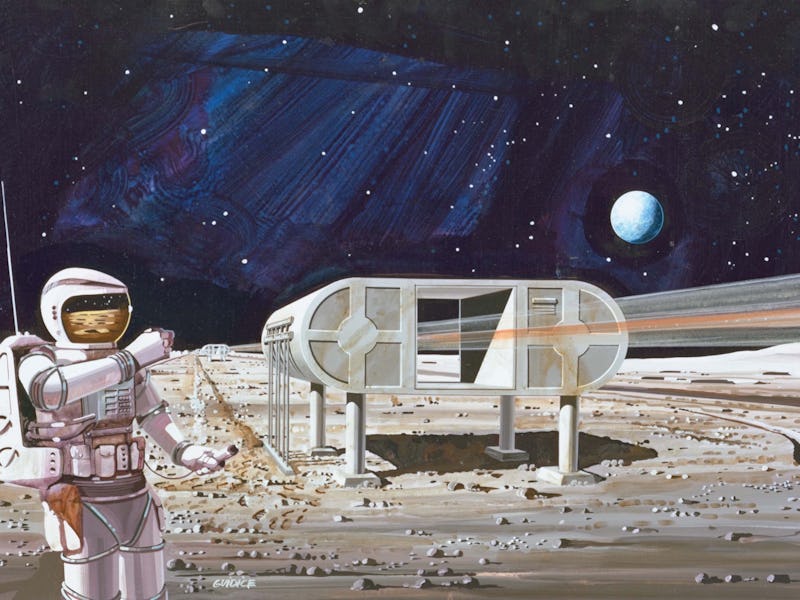Three unexpected tools could make human space colonies a reality
We are getting closer to realizing our dreams of living on Mars and the Moon.

The 2020s are shaping up to be a new era of human space exploration. The industry has set its eyes on a return to the Moon by the year 2024, followed by the first human mission to Mars. The ultimate goal is to build human colonies on the lunar surface, which would serve as a kind of rest stop for future missions to Mars and other deep-space destinations. The most-ambitious plan comes from private aerospace company SpaceX, which hopes to colonize the Red Planet by the year 2050. But as we inch closer to making human colonies in outer space a reality, we're getting some of our first solid ideas of how these lunar habitats and Martian ecosystems might look.
It's also becoming clear that to be sustainable, these space cities will have to rely on some rather unusual tech — from mushroom homes to a lunar nuclear reactor. Here are three tools that could help us make our space-colony dreams a reality sooner rather than later.
Funghi architecture
Our imagination paints a picture of futuristic space cities composed of modern, sleek buildings. Just a glimpse at some of the mock-ups from Blue Origin or SpaceX envisaging these cityscapes demonstrates that the expectation for future space cities is that they will be modern and sleek, composed of glass buildings and impressive steel structures.
This artist's rendering shows one of Blue Origin's visions of a future space city.
But in reality, future buildings on the Moon and Mars may actually require us to revert back to one of the most basic elements in nature.
NASA’s myco-architecture project is prototyping a technology that uses mushrooms to grow habitats in space.
The idea behind the project is instead of carrying your entire house with you on your journey to Mars, future human settlers of the planet would be able to bring a compact habitat made of mycelia, which is the vegetative part of the fungus which forms fungi colonies through underground threads.
Once humans have landed on Mars, they would grow their own home by adding water and letting the fungus grow.
Future human settlers on Mars may be able to grow their own homes from this compact mushroom once they get there.
Cooking up oxygen on the Moon
The Moon’s atmosphere is very thin compared to Earth's. And while it does contain some oxygen, it is certainly not enough for humans to breathe long enough to get on a ride to Mars.
But lunar samples returned to Earth during past missions reveal there may be another source of this crucial element for humans to exploit. Lunar bedrock is made up of 40-45 percent oxygen, bound chemically as oxides in the form of minerals or glass. Mining the bedrock may help future lunar colonizers survive and sustain new habitats.
Currently, the European Space Agency is working on creating an oxygen plant to extract oxygen from the Moon’s bedrock.
Researchers experiment with extracting oxygen from lunar bedrock in the lab.
The oxygen plant works by placing the moon dust in a metal basket with molten calcium chloride salt to serve as an electrolyte. By heating the bedrock material to 950 degrees Celsuis, and passing a current through it, the oxygen would be extracted and migrate across the salt to be collected at an anode.
Moondust simulant undergoing oxygen extraction in the lab.
A prototype of the plant is currently in place at the Materials and Electrical Components Laboratory of the European Space Research and Technology Centre in the Netherlands.
Generating energy off-Earth
One of the ultimate challenges for lie in a space colony is being able to power all of that machinery.
There's an idea that solar power could offer a renewable and sustainable energy source — especially in places where the Sun always shines.
A visualization of a human colony on the lunar surface — complete with potentially inefficient solar panels.
But solar panels may be inefficient in areas where there is little to no sunlight. On the Moon, this would quickly become a problem — the surface is dark for 14 days at a time, so there would be no constant source of power.
In order to address that challenge, NASA is developing a mobile nuclear reactor as part of Project Kilopower. The reactor would work is by splitting atoms and releasing energy in the form of heat, which is would then be converted into electricity.
An artist's rendering of Kilopower nuclear reactors on the lunar surface.
The reactor would be able to produce 10 kilowatts of electrical power on a continuous basis, and can last for up to 10 years. NASA demonstrated the reactor in action in May 2018 — four Kilopower units would provide enough power to several households. “Safe, efficient and plentiful energy will be the key to future robotic and human exploration,” said Jim Reuter, NASA’s acting associate administrator for the Space Technology Mission Directorate at the time. “I expect the Kilopower project to be an essential part of lunar and Mars power architectures as they evolve.”
As we continue to meet new challenges in bringing humans into space for the long-term, these three tools are likely only the start of a new era of innovation. Watch this space.